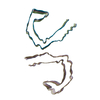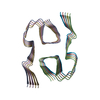+ データを開く
データを開く
- 基本情報
基本情報
| 登録情報 |  | |||||||||
|---|---|---|---|---|---|---|---|---|---|---|
| タイトル | PHF Tau from Down Syndrome | |||||||||
 マップデータ マップデータ | ||||||||||
 試料 試料 |
| |||||||||
 キーワード キーワード | PHF Tau / Tau Filament / Down Syndrome / NEUROPEPTIDE / Human Trisomy 21 | |||||||||
| 機能・相同性 |  機能・相同性情報 機能・相同性情報plus-end-directed organelle transport along microtubule / histone-dependent DNA binding / neurofibrillary tangle assembly / positive regulation of diacylglycerol kinase activity / axonal transport / negative regulation of establishment of protein localization to mitochondrion / neurofibrillary tangle / positive regulation of protein localization to synapse / microtubule lateral binding / negative regulation of mitochondrial fission ...plus-end-directed organelle transport along microtubule / histone-dependent DNA binding / neurofibrillary tangle assembly / positive regulation of diacylglycerol kinase activity / axonal transport / negative regulation of establishment of protein localization to mitochondrion / neurofibrillary tangle / positive regulation of protein localization to synapse / microtubule lateral binding / negative regulation of mitochondrial fission / tubulin complex / phosphatidylinositol bisphosphate binding / main axon / regulation of long-term synaptic depression / negative regulation of kinase activity / negative regulation of tubulin deacetylation / generation of neurons / positive regulation of protein localization / rRNA metabolic process / internal protein amino acid acetylation / regulation of chromosome organization / regulation of mitochondrial fission / axonal transport of mitochondrion / intracellular distribution of mitochondria / axon development / central nervous system neuron development / regulation of microtubule polymerization / microtubule polymerization / minor groove of adenine-thymine-rich DNA binding / lipoprotein particle binding / dynactin binding / glial cell projection / apolipoprotein binding / negative regulation of mitochondrial membrane potential / protein polymerization / axolemma / Caspase-mediated cleavage of cytoskeletal proteins / regulation of microtubule polymerization or depolymerization / positive regulation of axon extension / regulation of microtubule cytoskeleton organization / Activation of AMPK downstream of NMDARs / cytoplasmic microtubule organization / supramolecular fiber organization / regulation of cellular response to heat / stress granule assembly / positive regulation of superoxide anion generation / regulation of calcium-mediated signaling / axon cytoplasm / positive regulation of microtubule polymerization / somatodendritic compartment / synapse assembly / cellular response to brain-derived neurotrophic factor stimulus / astrocyte activation / phosphatidylinositol binding / nuclear periphery / cellular response to nerve growth factor stimulus / protein phosphatase 2A binding / regulation of autophagy / response to lead ion / synapse organization / microglial cell activation / cellular response to reactive oxygen species / Hsp90 protein binding / PKR-mediated signaling / protein homooligomerization / regulation of synaptic plasticity / memory / activation of cysteine-type endopeptidase activity involved in apoptotic process / microtubule cytoskeleton organization / SH3 domain binding / cytoplasmic ribonucleoprotein granule / microtubule cytoskeleton / neuron projection development / cell-cell signaling / double-stranded DNA binding / protein-macromolecule adaptor activity / single-stranded DNA binding / actin binding / protein-folding chaperone binding / cellular response to heat / cell body / growth cone / microtubule binding / sequence-specific DNA binding / amyloid fibril formation / microtubule / learning or memory / dendritic spine / nuclear speck / neuron projection / membrane raft / axon / negative regulation of gene expression / neuronal cell body / DNA damage response / dendrite / protein kinase binding / enzyme binding / mitochondrion / DNA binding 類似検索 - 分子機能 | |||||||||
| 生物種 |  Homo sapiens (ヒト) Homo sapiens (ヒト) | |||||||||
| 手法 | らせん対称体再構成法 / クライオ電子顕微鏡法 / 解像度: 2.9 Å | |||||||||
 データ登録者 データ登録者 | Hoq MR / Bharath SR / Jiang W / Vago FS | |||||||||
| 資金援助 |  米国, 1件 米国, 1件
| |||||||||
 引用 引用 |  ジャーナル: Nat Struct Mol Biol / 年: 2024 ジャーナル: Nat Struct Mol Biol / 年: 2024タイトル: Cryo-EM structures of amyloid-β and tau filaments in Down syndrome. 著者: Anllely Fernandez / Md Rejaul Hoq / Grace I Hallinan / Daoyi Li / Sakshibeedu R Bharath / Frank S Vago / Xiaoqi Zhang / Kadir A Ozcan / Kathy L Newell / Holly J Garringer / Wen Jiang / ...著者: Anllely Fernandez / Md Rejaul Hoq / Grace I Hallinan / Daoyi Li / Sakshibeedu R Bharath / Frank S Vago / Xiaoqi Zhang / Kadir A Ozcan / Kathy L Newell / Holly J Garringer / Wen Jiang / Bernardino Ghetti / Ruben Vidal /  要旨: Adult individuals with Down syndrome (DS) develop Alzheimer disease (AD). Whether there is a difference between AD in DS and AD regarding the structure of amyloid-β (Aβ) and tau filaments is ...Adult individuals with Down syndrome (DS) develop Alzheimer disease (AD). Whether there is a difference between AD in DS and AD regarding the structure of amyloid-β (Aβ) and tau filaments is unknown. Here we report the structure of Aβ and tau filaments from two DS brains. We found two Aβ filaments (types IIIa and IIIb) that differ from those previously reported in sporadic AD and two types of Aβ filaments (I and II) identical to those found in sporadic and familial AD. Tau filaments (paired helical filaments and straight filaments) were identical to those in AD, supporting the notion of a common mechanism through which amyloids trigger aggregation of tau. This knowledge is important for understanding AD in DS and assessing whether adults with DS could be included in AD clinical trials. | |||||||||
| 履歴 |
|
- 構造の表示
構造の表示
| 添付画像 |
|---|
- ダウンロードとリンク
ダウンロードとリンク
-EMDBアーカイブ
| マップデータ |  emd_40411.map.gz emd_40411.map.gz | 8.7 MB |  EMDBマップデータ形式 EMDBマップデータ形式 | |
|---|---|---|---|---|
| ヘッダ (付随情報) |  emd-40411-v30.xml emd-40411-v30.xml emd-40411.xml emd-40411.xml | 13.9 KB 13.9 KB | 表示 表示 |  EMDBヘッダ EMDBヘッダ |
| FSC (解像度算出) |  emd_40411_fsc.xml emd_40411_fsc.xml | 9.9 KB | 表示 |  FSCデータファイル FSCデータファイル |
| 画像 |  emd_40411.png emd_40411.png | 42.1 KB | ||
| Filedesc metadata |  emd-40411.cif.gz emd-40411.cif.gz | 5.1 KB | ||
| その他 |  emd_40411_half_map_1.map.gz emd_40411_half_map_1.map.gz emd_40411_half_map_2.map.gz emd_40411_half_map_2.map.gz | 65.3 MB 65.3 MB | ||
| アーカイブディレクトリ |  http://ftp.pdbj.org/pub/emdb/structures/EMD-40411 http://ftp.pdbj.org/pub/emdb/structures/EMD-40411 ftp://ftp.pdbj.org/pub/emdb/structures/EMD-40411 ftp://ftp.pdbj.org/pub/emdb/structures/EMD-40411 | HTTPS FTP |
-検証レポート
| 文書・要旨 |  emd_40411_validation.pdf.gz emd_40411_validation.pdf.gz | 773.3 KB | 表示 |  EMDB検証レポート EMDB検証レポート |
|---|---|---|---|---|
| 文書・詳細版 |  emd_40411_full_validation.pdf.gz emd_40411_full_validation.pdf.gz | 772.9 KB | 表示 | |
| XML形式データ |  emd_40411_validation.xml.gz emd_40411_validation.xml.gz | 17.2 KB | 表示 | |
| CIF形式データ |  emd_40411_validation.cif.gz emd_40411_validation.cif.gz | 22.7 KB | 表示 | |
| アーカイブディレクトリ |  https://ftp.pdbj.org/pub/emdb/validation_reports/EMD-40411 https://ftp.pdbj.org/pub/emdb/validation_reports/EMD-40411 ftp://ftp.pdbj.org/pub/emdb/validation_reports/EMD-40411 ftp://ftp.pdbj.org/pub/emdb/validation_reports/EMD-40411 | HTTPS FTP |
-関連構造データ
- リンク
リンク
| EMDBのページ |  EMDB (EBI/PDBe) / EMDB (EBI/PDBe) /  EMDataResource EMDataResource |
|---|---|
| 「今月の分子」の関連する項目 |
- マップ
マップ
| ファイル |  ダウンロード / ファイル: emd_40411.map.gz / 形式: CCP4 / 大きさ: 83.7 MB / タイプ: IMAGE STORED AS FLOATING POINT NUMBER (4 BYTES) ダウンロード / ファイル: emd_40411.map.gz / 形式: CCP4 / 大きさ: 83.7 MB / タイプ: IMAGE STORED AS FLOATING POINT NUMBER (4 BYTES) | ||||||||||||||||||||
|---|---|---|---|---|---|---|---|---|---|---|---|---|---|---|---|---|---|---|---|---|---|
| ボクセルのサイズ | X=Y=Z: 1.054 Å | ||||||||||||||||||||
| 密度 |
| ||||||||||||||||||||
| 対称性 | 空間群: 1 | ||||||||||||||||||||
| 詳細 | EMDB XML:
|
-添付データ
-ハーフマップ: #2
| ファイル | emd_40411_half_map_1.map | ||||||||||||
|---|---|---|---|---|---|---|---|---|---|---|---|---|---|
| 投影像・断面図 |
| ||||||||||||
| 密度ヒストグラム |
-ハーフマップ: #1
| ファイル | emd_40411_half_map_2.map | ||||||||||||
|---|---|---|---|---|---|---|---|---|---|---|---|---|---|
| 投影像・断面図 |
| ||||||||||||
| 密度ヒストグラム |
- 試料の構成要素
試料の構成要素
-全体 : Helical Filaments
| 全体 | 名称: Helical Filaments |
|---|---|
| 要素 |
|
-超分子 #1: Helical Filaments
| 超分子 | 名称: Helical Filaments / タイプ: tissue / ID: 1 / 親要素: 0 / 含まれる分子: all |
|---|---|
| 由来(天然) | 生物種:  Homo sapiens (ヒト) Homo sapiens (ヒト) |
-分子 #1: Microtubule-associated protein tau
| 分子 | 名称: Microtubule-associated protein tau / タイプ: protein_or_peptide / ID: 1 / コピー数: 10 / 光学異性体: LEVO |
|---|---|
| 由来(天然) | 生物種:  Homo sapiens (ヒト) Homo sapiens (ヒト) |
| 分子量 | 理論値: 7.940141 KDa |
| 組換発現 | 生物種:  Homo sapiens (ヒト) Homo sapiens (ヒト) |
| 配列 | 文字列: VQIVYKPVDL SKVTSKCGSL GNIHHKPGGG QVEVKSEKLD FKDRVQSKIG SLDNITHVPG GGNKKIETHK LTF UniProtKB: Microtubule-associated protein tau |
-実験情報
-構造解析
| 手法 | クライオ電子顕微鏡法 |
|---|---|
 解析 解析 | らせん対称体再構成法 |
| 試料の集合状態 | filament |
- 試料調製
試料調製
| 濃度 | 1 mg/mL |
|---|---|
| 緩衝液 | pH: 7.2 |
| 凍結 | 凍結剤: ETHANE |
- 電子顕微鏡法
電子顕微鏡法
| 顕微鏡 | TFS KRIOS |
|---|---|
| 撮影 | フィルム・検出器のモデル: GATAN K3 (6k x 4k) / 平均露光時間: 1.103 sec. / 平均電子線量: 50.46 e/Å2 |
| 電子線 | 加速電圧: 300 kV / 電子線源:  FIELD EMISSION GUN FIELD EMISSION GUN |
| 電子光学系 | C2レンズ絞り径: 100.0 µm / 照射モード: SPOT SCAN / 撮影モード: BRIGHT FIELD / Cs: 2.7 mm / 最大 デフォーカス(公称値): 5.0 µm / 最小 デフォーカス(公称値): 0.5 µm / 倍率(公称値): 81000 |
| 試料ステージ | ホルダー冷却材: NITROGEN |
| 実験機器 |  モデル: Titan Krios / 画像提供: FEI Company |
 ムービー
ムービー コントローラー
コントローラー


















 Z
Z Y
Y X
X


















